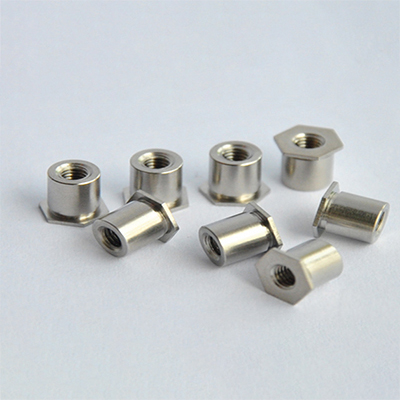Self-clinching Studs and Self-clinching Nuts are both types of fasteners designed to create threads in thin metal sheets without the need for additional components. While they share similarities in their basic function, there are distinct differences between these two types of Self-clinching fasteners in terms of design, application, and usage.

Self-Clinching Studs:
Self-clinching studs are fasteners with an externally threaded shank and a specially designed base that allows them to be securely clinched (pressed) into a pre-punched or pre-drilled hole in a metal sheet. The base of the stud typically features knurls or serrations that grip the material during installation. Once installed, the stud becomes a permanent part of the assembly, with the threaded shank protruding on one side of the metal sheet.
Self-clinching nuts, on the other hand, are fasteners designed to provide internally threaded holes in thin metal sheets. These nuts have a specialized design with features such as knurls or serrations that embed into the material when pressed into a pre-punched or pre-drilled hole. The embedded features create a secure grip, and the nut becomes permanently affixed to the metal sheet. Once installed, self-clinching nuts offer a reliable and permanent threaded hole, allowing screws or bolts to be inserted and tightened.
Key Differences:
1. Function and Design: Self-clinching studs have an externally threaded shank and are used to provide a threaded protrusion for mating components, while self-clinching nuts create internally threaded holes to accept screws or bolts.
2. Application: Self-clinching studs are often used when a threaded protrusion is required for securing components, while self-clinching nuts are used when a threaded hole is needed for attaching screws or bolts.
3. Installation Orientation: Self-clinching studs are typically installed with the threaded shank protruding from one side of the metal sheet, while self-clinching nuts are embedded within the sheet and do not protrude.
4. Mating Components: Self-clinching studs require mating nuts or fasteners on the exposed threads, whereas self-clinching nuts accept mating screws or bolts directly.
In summary, while both self-clinching studs and self-clinching nuts offer efficient and reliable solutions for creating threads in thin metal sheets, their distinct designs and applications make them suitable for different scenarios. The choice between the two depends on the specific requirements of the assembly and the desired fastening outcome.
Previous: What are Flare Nuts made of?